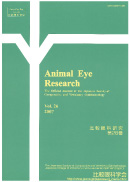All issues

Volume 26
Displaying 1-2 of 2 articles from this issue
- |<
- <
- 1
- >
- >|
Original Report
-
Kazutaka KANAI, Nobuyuki KANEMAKI, Akira YOSHINO, Yasunori WADAArticle type: Original Report
2007Volume 26 Pages 13-18
Published: January 31, 2008
Released on J-STAGE: September 11, 2013
JOURNAL FREE ACCESSIntraocular inflammation was induced in Sprague-Dawley rat by intravitreal injection of Salmonella endotoxin in order to study the utility of endotoxin induced uveitis model for the pharmacologic evaluation of potential anti-inflammatory compounds. Ocular inflammatory mediated parameters were assessed at 0 hours before the lipopolysaccharide (LPS) injection (naive control) and at 3, 12 and 24 hours after that as well as in control rats, by measuring infiltrating cell count, protein concentration, prostaglandin E2 (PGE2) and nitric oxide (NO) level in the aqueous humor. Infiltrating cell count after LPS vitreous injection at 24 hours (82 ± 32.1 x 105 cells /ml) significantly increased in comparison with naive control (0 ± 0 x 105 cells /ml) or phosphate buffer saline (PBS) vitreous injection (0.1 ± 0.2 x 105 cells /ml) respectively. Protein concentration was significantly elevated after LPS injection at 3 (12.4 ± 3.3 mg/ml), 12 (15.5 ± 7.6 mg/ml) 24 hours (14.1 ±1.5 mg/ml) compared to naive control (3.8 ±1.9 mg/ml). In contrast, protein concentration after PBS vitreous injection (control) was significantly elevated at 3 (10.9 ±3.2 mg/ml) and 12 hours (6.0 ± 0.9 mg/ml), the protein concentration 24 hours later decreased (5.3 ± 0.9 mg/ml) and no significant differences were found when compared to naive control (3.8 ±1.9 mg/ml). Significant differences between the LPS injection and control at the same respective times were seen at 12 and 24 hours after the vitreous injection. PGE2 and NO level was significantly higher than in naive control (348.9 ± 200.8 pg/ml and 179.8 ± 47.5 μmol/ml) starting at 12 hours after the injection of LPS into the vitreous, and reached a maximum value 24 hours later (949.5 ± 218.6 pg/ml and 407.6 ± 59.7μmol/ml). In contrast, PGE2 and NO level were significantly elevated after PBS vitreous injection at 12 hours (762.1 ± 148.7 pg/ml and 272.3 ± 10.8 μmol/ml) in comparison with naive control (348.9 ± 200.8 pg/ml and 179.8 ± 47.5 μmol/ml). These results demonstrate that influence of the vitreum injection is present until 12 hours later because the value of the inflammatory mediated parameters in PBS injection significantly increased in comparison with naive control. However, since all inflammatory parameters at 24 hours after LPS vitreous injection significantly increased in comparison with naive control or the PBS injection respectively, this model of ocular inflammation would appear to be suitable for the pharmacologic evaluation of potential anti-inflammatory compounds.View full abstractDownload PDF (738K)
Case Report
-
Motohide KOBAYASHI, Eiji KAWADA, Toyohiko AOKIArticle type: Case Report
2007Volume 26 Pages 19-24
Published: January 31, 2008
Released on J-STAGE: September 11, 2013
JOURNAL FREE ACCESSIn total 30 male and 30 female (Crlj: CD1 (ICR)) mice were purchased and maintained to gather background data for pre-clinical general toxicity testing. One of the females was accidentally injured in the right eye during the experiment, and a sequence of ocular complications was observed in the right eye, including orbital hemorrhage, proptosis, and corneal leukoma on the day of injury (Day 1), atrophy of the eye from Day 3, and hemorrhage in the anterior chamber and opacity of the lens from Day 6. The atrophy of the eye and opacity of the lens persisted until the day of autopsy 28 days after injury. On histopathological examination of the eye, degeneration of all the intraocular tissues was observed. Phthisis bulbus was therefore diagnosed, and appeared to have developed within 5 days after the injury. There have been many clinical reports of phthisis bulbi caused by injuries. Our findings demonstrate that the same condition can occur in laboratory mice.View full abstractDownload PDF (1757K)
- |<
- <
- 1
- >
- >|